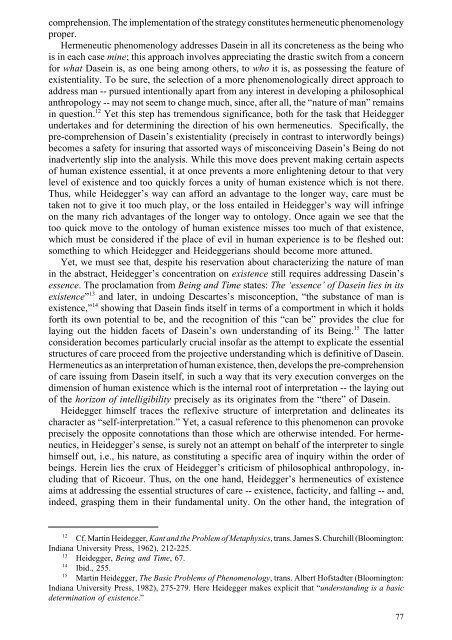[Andrzej_Wiercinski_(ed ... - WordPress.com
[Andrzej_Wiercinski_(ed ... - WordPress.com
[Andrzej_Wiercinski_(ed ... - WordPress.com
Create successful ePaper yourself
Turn your PDF publications into a flip-book with our unique Google optimized e-Paper software.
<strong>com</strong>prehension. The implementation of the strategy constitutes hermeneutic phenomenologyproper.Hermeneutic phenomenology addresses Dasein in all its concreteness as the being whois in each case mine; this approach involves appreciating the drastic switch from a concernfor what Dasein is, as one being among others, to who it is, as possessing the feature ofexistentiality. To be sure, the selection of a more phenomenologically direct approach toaddress man -- pursu<strong>ed</strong> intentionally apart from any interest in developing a philosophicalanthropology -- may not seem to change much, since, after all, the “nature of man” remainsin question. 12 Yet this step has tremendous significance, both for the task that Heideggerundertakes and for determining the direction of his own hermeneutics. Specifically, thepre-<strong>com</strong>prehension of Dasein’s existentiality (precisely in contrast to interwordly beings)be<strong>com</strong>es a safety for insuring that assort<strong>ed</strong> ways of misconceiving Dasein’s Being do notinadvertently slip into the analysis. While this move does prevent making certain aspectsof human existence essential, it at once prevents a more enlightening detour to that verylevel of existence and too quickly forces a unity of human existence which is not there.Thus, while Heidegger’s way can afford an advantage to the longer way, care must betaken not to give it too much play, or the loss entail<strong>ed</strong> in Heidegger’s way will infringeon the many rich advantages of the longer way to ontology. Once again we see that thetoo quick move to the ontology of human existence misses too much of that existence,which must be consider<strong>ed</strong> if the place of evil in human experience is to be flesh<strong>ed</strong> out:something to which Heidegger and Heideggerians should be<strong>com</strong>e more attun<strong>ed</strong>.Yet, we must see that, despite his reservation about characterizing the nature of manin the abstract, Heidegger’s concentration on existence still requires addressing Dasein’sessence. The proclamation from Being and Time states: The ‘essence’ of Dasein lies in itsexistence” 13 and later, in undoing Descartes’s misconception, “the substance of man isexistence,” 14 showing that Dasein finds itself in terms of a <strong>com</strong>portment in which it holdsforth its own potential to be, and the recognition of this “can be” provides the clue forlaying out the hidden facets of Dasein’s own understanding of its Being. 15 The latterconsideration be<strong>com</strong>es particularly crucial insofar as the attempt to explicate the essentialstructures of care proce<strong>ed</strong> from the projective understanding which is definitive of Dasein.Hermeneutics as an interpretation of human existence, then, develops the pre-<strong>com</strong>prehensionof care issuing from Dasein itself, in such a way that its very execution converges on th<strong>ed</strong>imension of human existence which is the internal root of interpretation -- the laying outof the horizon of intelligibility precisely as its originates from the “there” of Dasein.Heidegger himself traces the reflexive structure of interpretation and delineates itscharacter as “self-interpretation.” Yet, a casual reference to this phenomenon can provokeprecisely the opposite connotations than those which are otherwise intend<strong>ed</strong>. For hermeneutics,in Heidegger’s sense, is surely not an attempt on behalf of the interpreter to singlehimself out, i.e., his nature, as constituting a specific area of inquiry within the order ofbeings. Herein lies the crux of Heidegger’s criticism of philosophical anthropology, includingthat of Ricoeur. Thus, on the one hand, Heidegger’s hermeneutics of existenceaims at addressing the essential structures of care -- existence, facticity, and falling -- and,inde<strong>ed</strong>, grasping them in their fundamental unity. On the other hand, the integration of12Cf. Martin Heidegger, Kant and the Problem of Metaphysics, trans. James S. Churchill (Bloomington:Indiana University Press, 1962), 212-225.13Heidegger, Being and Time, 67.14Ibid., 255.15Martin Heidegger, The Basic Problems of Phenomenology, trans. Albert Hofstadter (Bloomington:Indiana University Press, 1982), 275-279. Here Heidegger makes explicit that “understanding is a basicdetermination of existence.”77


